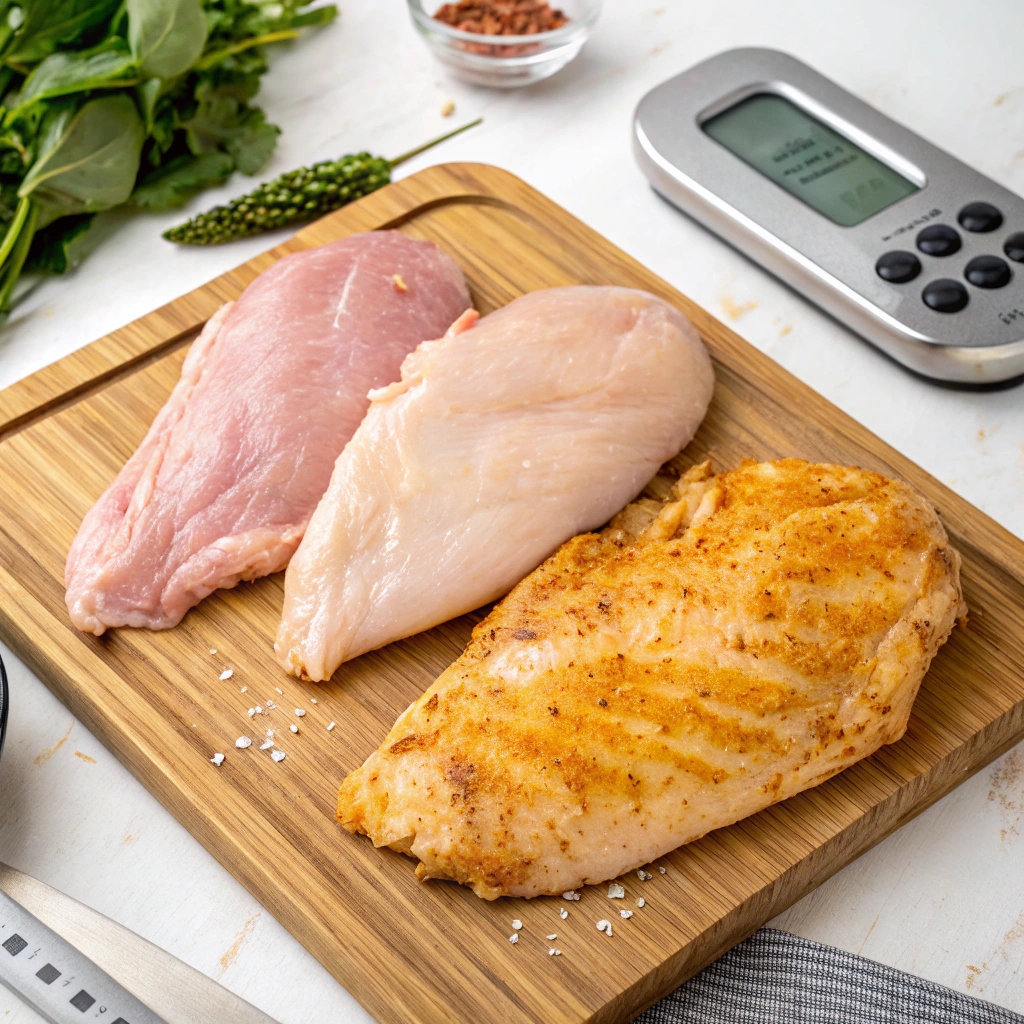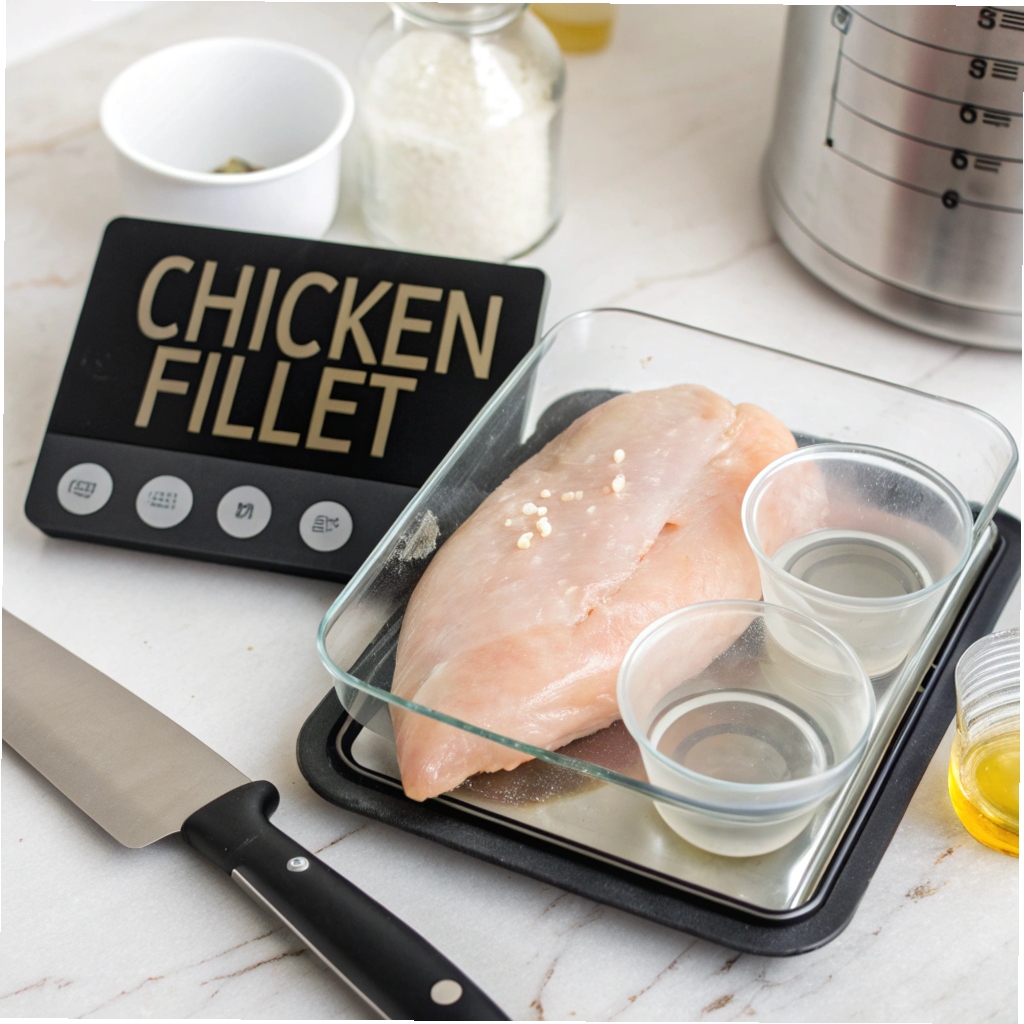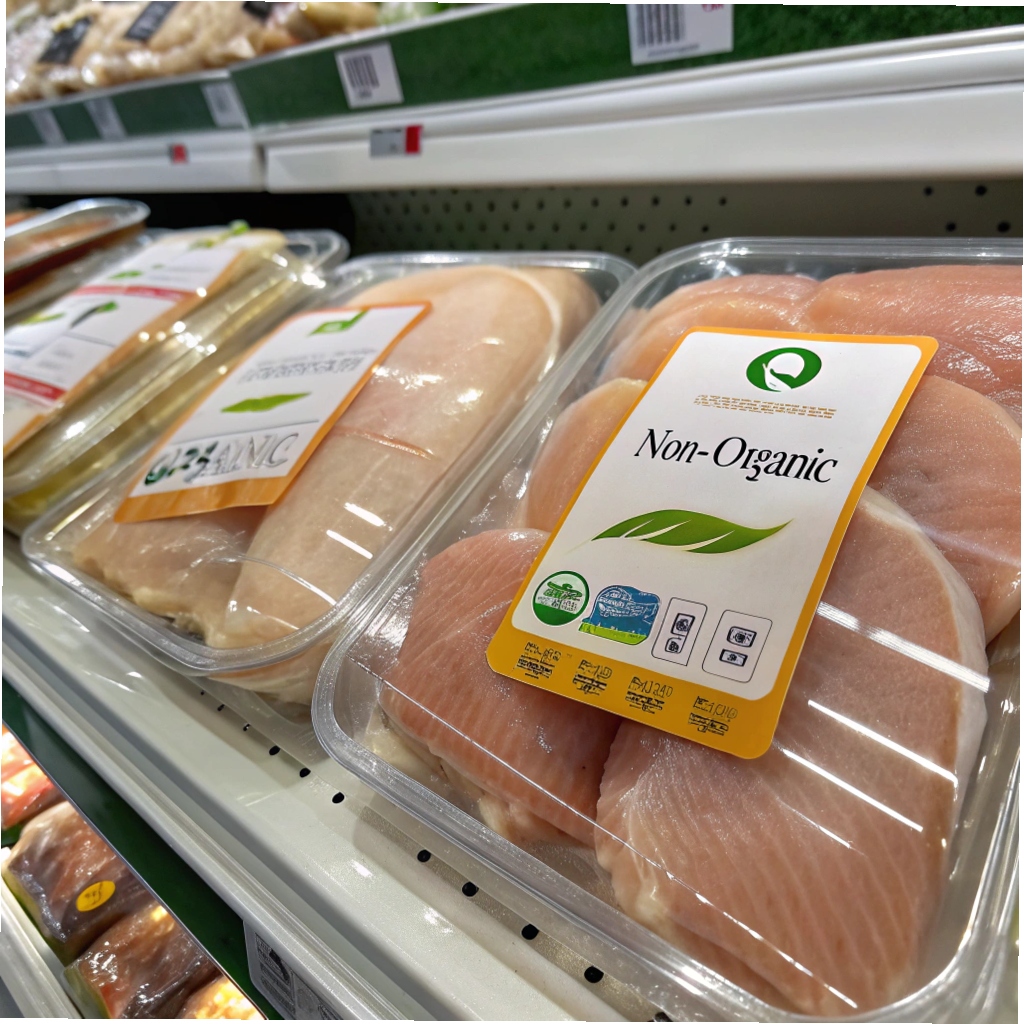Chicken breast is one of the most versatile and popular proteins in the world. Whether you’re meal prepping, watching your calorie intake, or trying to meet your fitness goals, knowing the weight of a chicken breast portion can make a big difference. 🐓
So, how much does a portion of chicken breast weigh? Typically, a single chicken breast weighs between 6 to 8 ounces (170-227 grams) when raw, but this can vary. The weight changes after cooking due to water loss, and that’s just one factor to consider.
Let’s dive into why understanding chicken breast weight matters and how you can measure it accurately.
Table of contents
Why Knowing the Weight of Chicken Breast Portions Matters
Benefits of Accurate Portioning
- Nutritional Accuracy: Knowing the exact weight helps you calculate calories, protein, and other nutrients.
- Cost-Effectiveness: Proper portioning can save money by preventing waste.
- Consistency: Perfectly sized portions ensure even cooking and predictable results.
Common Problems with Estimating Weight
- Overeating or Undereating: Without proper measurements, you might eat more (or less) than intended.
- Recipe Inconsistencies: Not all recipes specify portion sizes, leading to guesswork.
- Nutritional Miscalculations: A wrong estimate can throw off your entire meal plan.
Pro Tip: Always use a reliable kitchen scale to avoid these pitfalls!
Average Weight of a Chicken Breast
Chicken breasts come in different sizes, so let’s break it down.
Raw vs. Cooked Weight
A raw chicken breast loses about 20-25% of its weight during cooking. For example:
- Raw: 8 oz (227 g)
- Cooked: ~6 oz (170 g)
Skinless vs. Skin-On
Skin-on Chicken Breast Weigh more due to the added layer of fat. Removing the skin can reduce the weight by 10-20 grams.
Factors That Affect Weight
- Brand/Type: Organic or free-range chickens tend to have smaller breasts.
- Processing: Some commercially sold chicken breasts are injected with water or saline, increasing their weight artificially.

How to Measure Chicken Breast Weight
Measuring chicken breast weight can be straightforward with the right approach.
Using a Kitchen Scale
- Step 1: Turn on your scale and set it to grams or ounces.
- Step 2: Place the chicken breast on the scale.
- Step 3: Note the weight before cooking.
Visual Estimation Techniques
If you don’t have a scale, you can estimate:
- A 4-ounce portion is roughly the size of a deck of cards. 🃏
- A whole chicken breast is generally double that size.
Portioning Without Tools
- Use your hand! A portion roughly the size of your palm (not including fingers) equals 3-4 ounces.
Nutrition Facts Table (per 4 oz / 113 g cooked chicken breast):
| Nutrient | Amount |
|---|---|
| Calories | 165 |
| Protein | 31 g |
| Fat | 3.6 g |
| Carbohydrates | 0 g |

Cooking Methods, Nutrition Breakdown, and Portioning Tips
Chicken Breast Weigh might be simple, but how you prepare it can significantly affect its weight, texture, and nutritional value. Whether you grill, bake, or fry, cooking methods play a big role in how much of that juicy protein makes it to your plate.
Common Cooking Methods and How They Affect Weight
Cooking chicken breast can cause it to lose water and fat, which reduces its weight. Here’s how popular methods compare:
Grilling
Grilling is one of the healthiest ways to cook chicken breast, but it leads to the most weight loss. Why? The high heat evaporates water quickly. Expect a 20-25% reduction in weight.
Example: A raw 8 oz (227 g) chicken breast weighs about 6 oz (170 g) after grilling.
Baking
Baking retains more moisture than grilling, but the weight still drops by about 15-20%. Covering the chicken with foil or using a marinade can help reduce moisture loss.
Frying
Frying locks in moisture and even adds weight due to the oil absorption. However, this method is higher in calories because of the added fat.
Fun Fact: Did you know that poaching (boiling chicken in water or broth) can retain almost all of its weight while keeping it juicy and tender? Try it for meal prep! 🥘
Chicken Breast Weight and Nutrition Facts
What makes chicken breast a fitness favorite? Its high protein content and low fat! Here’s a breakdown of what you get from a cooked 4 oz (113 g) serving:
| Nutrient | Amount | Why It’s Important |
|---|---|---|
| Calories | 165 | Provides energy for daily activities. |
| Protein | 31 g | Essential for muscle building and repair. |
| Fat | 3.6 g | A small amount of fat helps absorb vitamins. |
| Carbs | 0 g | Perfect for low-carb and keto diets. |
| Cholesterol | 85 mg | Healthy in moderation, essential for hormones. |
| Sodium | 75 mg | Naturally low in salt, making it heart-friendly. |
How Cooking Changes Nutritional Value
Cooking doesn’t just shrink the chicken breast; it also alters its nutritional profile slightly:
- Protein Concentration: Cooking removes water, making the protein content more concentrated.
- Fat Changes: If you grill or bake, you lose some fat, but frying increases fat content due to oil absorption.
Portion Size Recommendations for Different Diets
The ideal Chicken breast weigh portion depends on your goals. Let’s break it down:
For Weight Loss Diets
Stick to 4-5 oz (113-142 g) of cooked chicken breast per meal. This size is low in calories but high in protein, keeping you full longer.
Tip: Pair chicken with non-starchy veggies like broccoli or spinach for a filling, low-calorie meal.
For Muscle Gain Diets
To build muscle, aim for 6-8 oz (170-227 g) per meal. This provides plenty of protein to support recovery after workouts.
Pro Tip: Add a carb source like sweet potatoes or rice to fuel your workouts and recovery.
For Balanced Nutrition
A balanced portion is around 5-6 oz (142-170 g). This size fits most meal plans and offers enough protein without overloading on calories.
Frequently Asked Questions About Chicken Breast Weight
Let’s address some burning questions you might have:
Does Bone-In Chicken Weigh More?
Yes! Bone-in chicken breasts weigh about 20-25% more than boneless. If you’re calculating portions, remember to account for the bones.
How Many Chicken Breasts Make a Pound?
Typically, 2-3 medium chicken breasts equal a pound (16 oz). Larger breasts can weigh up to 8 oz each, so you might only need two.
Should I Weigh Chicken Breast Raw or Cooked?
For accurate nutrition tracking, weigh it raw. Cooking reduces the weight, but the nutritional values are based on the raw portion.
Quote to Remember:
“Portion control isn’t about restriction—it’s about balance and consistency. Measuring your chicken breast is just one way to take control of your health.”
Tips for Choosing and Preparing Chicken Breast Portions
When it comes to choosing the right chicken breast, consistency is key. Not all chicken breasts are created equal—they can vary in size, quality, and weight depending on how they’re processed and sourced. In this section, we’ll go over how to pick the perfect chicken breast and make portioning a breeze.
Tips for Choosing the Right Chicken Breast Weigh Portions
1. Shop for Consistent Sizes
Buying chicken breasts of similar size ensures even cooking. Larger pieces can take longer to cook, while smaller ones might dry out. To keep things simple, look for pre-packaged chicken labeled as “uniform size” or opt for individually wrapped portions.
Pro Tip: If you’re buying in bulk, look for packs where the chicken breasts are around the same size. This will save time during prep and cooking.
2. Know the Difference Between Fresh and Frozen
Fresh chicken breasts tend to be less processed and don’t contain added water or brine, which can inflate their weight. On the other hand, frozen chicken breasts may have additives that affect the taste and weight after cooking.
- Fresh Chicken: More natural flavor and texture.
- Frozen Chicken: Convenient, but check the label for added ingredients like saline.
3. Organic vs. Conventional
Organic chicken breasts often come from smaller birds, resulting in lighter portions. While they might cost more, they’re free of hormones and antibiotics. Conventional chicken breasts, however, are usually larger and more affordable.
Did You Know? Organic chicken breasts are typically 20% smaller than conventionally raised ones.
Preparing Portions in Advance
Batch prepping chicken breasts can save time and effort throughout the week. Here’s how to make portioning easy:
1. Use a Kitchen Scale
As mentioned earlier, a kitchen scale is your best friend for accuracy. Weigh your chicken breasts raw, then cook and portion them according to your needs.
2. Slice Into Even Pieces
If your chicken breasts are too large, cut them in half lengthwise. This creates thinner, even-sized pieces that cook faster and are easier to portion.
3. Label and Store Portions
After cooking, divide your chicken into individual servings. Store them in airtight containers or freezer-safe bags, and label each one with the weight and date.
Storage Tip: Cooked chicken breasts can last up to 4 days in the refrigerator and up to 6 months in the freezer.

Quick Recipe Ideas for Pre-Portioned Chicken
Here are some easy, portion-friendly chicken recipes to try:
Grilled Chicken Salad Bowl 🍴
- Portion: 4 oz cooked chicken breast
- Ingredients: Mixed greens, cherry tomatoes, avocado, and a light vinaigrette
- Tip: Prep chicken in bulk and use it in salads for the next few days!
Chicken Stir-Fry 🍛
- Portion: 5 oz cooked chicken breast
- Ingredients: Bell peppers, broccoli, soy sauce, and a sprinkle of sesame seeds
- Tip: Cook chicken separately and mix it with stir-fried veggies when ready to eat.
Baked Chicken and Veggie Foil Packs 🥗
- Portion: 6 oz raw chicken breast per foil pack
- Ingredients: Zucchini, carrots, potatoes, and your favorite seasoning
- Tip: Prep and freeze foil packs, then bake them directly from the freezer.
How to Avoid Common Portioning Mistakes
Mistake 1: Forgetting to Account for Cooking Loss
As we mentioned earlier, chicken breasts lose about 20-25% of their weight during cooking. Always weigh your portions raw for the most accurate measurements.
Mistake 2: Overcooking the Chicken
Overcooked chicken is dry and unappetizing. Use a meat thermometer to ensure your chicken reaches an internal temperature of 165°F (74°C).
Mistake 3: Skipping the Marinade
A good marinade doesn’t just add flavor—it helps retain moisture during cooking, reducing weight loss.
Simple Marinade Recipe:
- 1/4 cup olive oil
- Juice of 1 lemon
- 2 garlic cloves (minced)
- 1 tsp salt and 1 tsp pepper
Marinate for at least 30 minutes before cooking.
Bonus: Visual Guide to Chicken Breast Weigh
| Portion Size | Looks Like | Ideal For |
|---|---|---|
| 3 oz | Deck of cards 🃏 | Light snacks, salads |
| 4 oz | Palm of your hand ✋ | Weight loss diets |
| 6 oz | Smartphone 📱 | Balanced meals |
| 8 oz | Small paperback book 📖 | Muscle gain diets |
Frequently Asked Questions About Chicken Breast Portions
1. How Much Is 1 Chicken Breast Weight?
The weight of a chicken breast varies, but on average, a raw chicken breast weighs between 6 to 8 ounces (170-227 grams). After cooking, it typically reduces to 4 to 6 ounces (113-170 grams) due to moisture loss.
2. How Big Is a 4 oz Chicken Breast?
A 4-ounce chicken breast is roughly the size of the palm of your hand or a deck of cards. It’s a common portion size for those following weight loss or calorie-controlled diets.
3. What Is a Portion Size of Cooked Chicken Breast?
A standard portion of cooked chicken breast is around 4 to 6 ounces. This size provides a balance of protein while keeping calorie intake manageable.
4. How Many Pounds Is a Serving of Chicken Breast?
A single serving of chicken breast is typically about 1/4 to 1/3 pound (4 to 6 ounces) when cooked. This means a pound of chicken breast can provide 3 to 4 servings, depending on portion size.
Final Thought: It’s All About Balance
Portioning chicken breast doesn’t have to feel like rocket science. With a little preparation and a few handy tricks, you can nail your portions every time. Remember, consistency is more important than perfection, so don’t stress over small variations.
“The secret to healthy eating isn’t complicated—it’s about knowing your portions, making smart choices, and enjoying the process!”
More Ideas
1. Master the Art of Chicken Recipes
Explore creative ways to use your perfectly portioned chicken breasts! Whether you’re cooking for one or meal-prepping for the week, these recipes will inspire you:
- Chicken Meets Pasta: How to Nail One-Pan Meals – Combine your portioned chicken with pasta for an easy, flavorful dish.
- Chicken Ricotta Meatballs – Transform chicken into tender, protein-packed meatballs that are perfect for any meal.
2. Make the Most of Your Leftovers
Don’t let overcooked or extra chicken go to waste! These guides will help you turn leftovers into delicious meals:
- Quick Fixes for Dry Leftover Chicken Recipes You’ll Love – Tips and recipes for saving dry chicken.
- Can You Eat Cold Pasta and Chicken? – Learn how to safely enjoy cold chicken and pasta dishes.
3. Pair Chicken with Flavorful Sides
Discover complementary dishes to elevate your chicken meals:
- Chicken Bacon Ranch Pasta Salad: A Perfect Blend of Flavors – A hearty side dish or meal on its own!
- Does Ranch Go Well With Pasta? – Find out why ranch and pasta make an excellent combo with chicken.
4. Learn More About Cooking Techniques
Master your chicken preparation with these helpful resources:
- How Do You Cook Ground Chicken? Easy Tips Everyone Can Try – A quick guide to perfect ground chicken dishes.
- Secrets to Making the Best Rotisserie Chicken Pasta – Combine tender rotisserie chicken with pasta for a crowd-pleaser.
Conclusion: Mastering Chicken Breast Portions
Chicken breast is a go-to protein for so many of us, whether we’re trying to eat healthier, lose weight, or build muscle. Understanding portion sizes and weight—both raw and cooked—can simplify meal planning and help you achieve your nutritional goals without the guesswork.
Remember, a typical chicken breast weighs 6 to 8 ounces raw and 4 to 6 ounces cooked, with portion sizes varying based on your dietary needs. Use tools like a kitchen scale, or simple visual cues, such as a deck of cards or your palm, to ensure accuracy.
Portioning doesn’t have to be a chore. With a little preparation, like batch cooking and dividing servings in advance, you can make meal prep a breeze while staying consistent with your goals.
Final Thought: “The key to a healthy and enjoyable diet isn’t perfection—it’s balance, preparation, and a little knowledge about what’s on your plate.”
Now you’re armed with all the information you need to measure, cook, and enjoy chicken breast portions like a pro. Ready to take your meal planning to the next level? Start practicing today!
